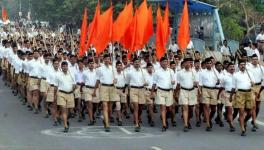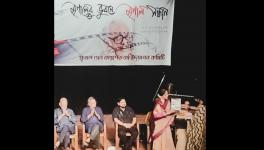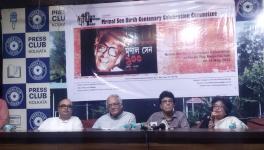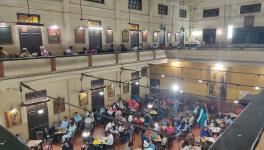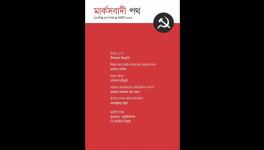‘Bharat Mata Temples Mushrooming in Kolkata Would Have Enraged Mrinal Sen’
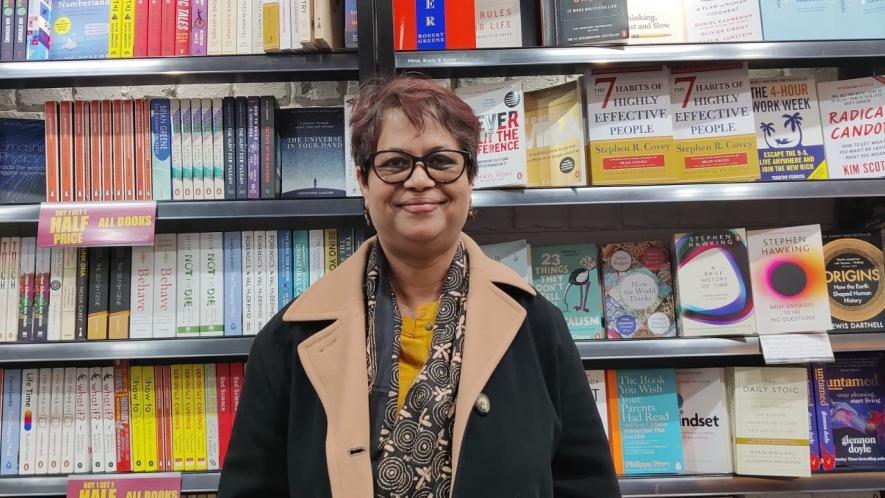
Dr. Sanghita Sen
This year marks the birth centenary of one of India’s most well-known Marxist film directors, Mrinal Sen. He passed away in December 2018, leaving behind an array of 27 feature films (mainly in Bangla), 14 short films and five documentaries, which are a living testimony to his Left ideology—although he never joined any communist party formally. He broke free from the shackles of conventional commercial cinema to portray poverty, deprivation and exploitation to educate the lower and middle classes about the hunger and misery of the poor. His rebellious films won global critical acclaim and a huge fan following across India. He once famously said that “since poverty, famine and social injustice are dominant facts of my own times, my business as a filmmaker is to understand them”. He revelled in telling stories of invisible and marginalised people.
S. N. M. Abdi discussed Mrinal Sen’s radicalism with Sanghita Sen, assistant professor in film at Northumbria University in Newcastle. The topic of Sen’s 2020 dissertation is: Recovering Indian Third Cinema Practice: A Study of the 1970s Films of Ritwik Ghatak, Mrinal Sen, and Satyajit Ray. Excerpts from the interview:
S N M Abdi: Do you think socialism was the driving force behind Mrinal Sen’s films?
Sanghita Sen: He described himself as a “private Marxist” time and again in interviews. So, yes, socialist sensibility and a deep commitment to social justice figure prominently in his creative practice. I say this not just based on his self-description but also by looking at his films closely. Like a true organic intellectual, he went on to critically highlight the social crises and inequalities that exist in society in his cinema. In the initial phase of his creative career, he exposed “the enemy outside”, while in his later films, he concentrated more on the “enemy within”. In any case, social, political and cultural injustice and inequality were at the core of his thoughts. The organised cultural movements propagated by the communist party since the early 1940s in general and the Indian People’s Theatres Association, in particular, deeply influenced his own cinematic craft. Although he was never a card-carrying member of any communist party in India, his close friendship with prominent Leftist creative practitioners and organic intellectuals in Bengal, such as Bijon Bhattacharya, Ritwik Ghatak, Salil Chowdhury, Hrishikesh Mukherjee, Utpal Dutt, Tapas Sen, Khaled Choudhury, Bansi Chandragupta, among others has been instrumental in shaping his creative worldview. Unfortunately, the connection between Sen’s cinema and contemporary theatrical practices is hardly discussed. But the Brechtian tenets in his films are a direct consequence of this association.
SNMA: Which films portray and showcase Mrinal Sen’s Left radicalism best?
SS: I think all of Sen’s work, spanning over five decades leading to a formidable corpus of 27 feature films, 14 short films, and five documentaries, showcase his Left radicalism to varying degrees, as this was the driving force of his thought process. However, the films made from the 1950s to the 1970s pulsate with a revolutionary sensibility and anger against social injustice and class hierarchies that seal the fate of the disenfranchised. As examples, I would like to mention a few films from this period, such as Baishey Shravana/Wedding Day (1960), Calcutta Quadrilogy comprising Interview (1970), Calcutta ’71 (1972), Padatik/The Guerilla Fighter (1973), and Chorus (1974). I would also include Mrigayaa/The Royal Hunt (1976), Oka Oori Katha/The Outsider (1977, Telugu), Ek Din Pratidin/And Quiet Rolls the Dawn (1979), and Kharij/The Case is Closed (1982) in the list of his deeply radical films that engage with politics in a broader sense.
SNMA: Can you tell us about the major influences on Mrinal Sen from within India and abroad?
SS: As an avid cinephile and a committed filmmaker, he was closely associated with his contemporary national and international artists. However, I am not sure about any direct influence of such associations. I think it is more of a synergy with the Leftist creative artists across the world and the Third Cinema filmmakers from the Global South. He was friends with Fernando Solanas, Julio García Espinosa, Miguel Littin, Gabriel García Márquez, and Lindsey Anderson, to name a few. It was a spirit of collaboration that existed among them rather than influence. For example, he used fragments from La Hora de los Hornos/The Hour of the Furnaces, a 1968 Argentinian documentary directed by Octavio Getino and Solanas in Padatik. Such cinematic “quotations” bear testimony to their collaborative spirit.
Back at home, one cannot help but notice the long-lasting impact of Nabanna (Bijon Bhattacharya, 1944), a path-breaking play on the Bengal famine of 1943, on Sen and his cinema. The famine sketches of Zainul Abedin, Somnath Hore, Chittaprosad, and Sunil Janah, exposing the connection between hunger and violence perpetrated by colonialism and capitalism, struck a chord in Sen and left an indelible mark, the signs of which are embodied in his cinema. Hunger and famine remained his lifelong interest as Bengal’s Partition and displacement remained a life-long preoccupation of Ghatak. His portrayal of hunger and social injustice connected him with the transnational Third Cinema practitioners who were also Marxist cultural activists.
In terms of experimentation with cinematic forms, there may have been some influence of the French Nouvelle Vague [New Wave], especially that of François Truffaut and Jean-Luc Godard and John Grierson, the Scottish documentary filmmaker. He had great regard for Satyajit Ray. However, one major influence on Sen was definitely that of Charlie Chaplin. Such was his admiration for Chaplin that he wrote a book on him; the cover was designed by Ray.
SNMA: Where would you place or position Mrinal Sen in the international film-making context?
SS: Mrinal Sen is one of the most prominent and prolific filmmakers from India who took Indian political cinema to the global arena. With his anti-colonial and Marxist demeanour, socialist realism and pioneering formal experimentation, and sharp critique of structural inequality and violence, Sen revolutionised Indian cinema. I place him among the world’s leading political filmmakers, such as Solanas, Glauber Rocha, Ousmane Sembène, Godard, Chris Marker, Cesare Zavattini and Ken Loach, among others. It is not just me, though. In Sen’s obituary published in Sight and Sound, noted British documentary filmmaker Mark Cousins compared him with Godard for his boldness and formal experimentation, to Zavattini and Loach for his depiction of the everyday and ordinary and placed him among the very greats of Third Cinema. I am in complete agreement.
SNMA: Was Mrinal Sen a fan of Fidel Castro?
SS: I’m not sure about that, but he knew Cuban filmmakers like Espinosa, Santiago Álvarez and visited Cuba along with [his wife] Geeta Sen more than once. It is likely he may have met Fidel Castro when he visited Cuba on an invitation to teach at the film school. Castro was a committed anti-imperialist crusader and charismatic communist leader of a poor country in the Global South. Sen may well have had positive views of him.
SNMA: While Mrinal Sen is labelled a socialist, Satyajit Ray is seen as a liberal humanist, and Ritwik Ghatak is regarded as a practising Marxist cultural activist. Do you agree with these tags?
SS: I feel tags are good for the purpose of classification, but they aren’t very useful in unravelling nuances in creative practitioners. Both Ghatak and Sen shared a common circle of Marxist intellectuals and activists throughout their lives. While the former was expelled from the Communist Party and the latter never took the party’s membership, both retained their Marxist views. The way they used cinema as a tool for social/political critique and extending solidarity to the dispossessed makes them both fervent cultural activists. When necessary, Ray also took to the streets. For example, Ray participated in a silent rally organised against the arrest of protesters of the food movement in the 1960s. Ray also participated in an anti-Vietnam War rally in Kolkata around the same time. Tagging them one way or the other doesn’t help see these nuances.
SNMA: How do you think Mrinal Sen would have responded to Hindutva’s rise in India—especially the exponential growth of the BJP in West Bengal?
SS: What the English poet PB Shelley said about the poets as “unacknowledged legislators of the world” is true for all artists. Although the Hindutva bandwagon is generously paying social media tributes to Mrinal Sen on his birth centenary, as a man of principle and committed Leftist artist, Sen would have sharply critiqued the way in which religious majoritarianism is wreaking havoc in the country’s democratic fibre, destroying the multicultural character of the society, and violating the Indian constitution on a regular basis by brutally crushing the dissenting voices, marginalising the Indian Muslims and other cultural minorities, pitting citizens against one another, and taking the country backwards by creating a near-civil-war-like volatile situation in India. The BJP and their Hindutva ideology stand for everything an organic intellectual like Sen fervently opposed throughout his life. He called Kolkata his El Dorado. He was a deeply political person aware of the menace that the strengthening of the RSS can lead to. Bharat Mata temples mushrooming in the lanes and bylanes of his El Dorado while government schools are closing down would have enraged him.
As I mentioned before, as a young man of 20, Sen witnessed the Bengal famine of 1943, which took the lives of three million Indians across the country. This left a permanent impression on him. Seeing India ranking 107th out of the 121 countries in the Global Hunger Index in 2022 while the BJP government’s sole commitment is towards benefiting the crony capitalists, Sen would have responded very critically. Great artists have the gift of foresight. Mrinal Sen-directed Chorus, Oka Oori Katha/ The Outsiders, and Parashuram/The Man with the Axe (1978)—and Ray’s Devi/ Goddess (1960), Mahapurush/The Holy Man (1965), and Ganashatru/ The Enemy of the People (1989) appear eerily contemporary in their depiction of social and political issues.
(S. N. M. Abdi is an independent journalist.)
Get the latest reports & analysis with people's perspective on Protests, movements & deep analytical videos, discussions of the current affairs in your Telegram app. Subscribe to NewsClick's Telegram channel & get Real-Time updates on stories, as they get published on our website.









